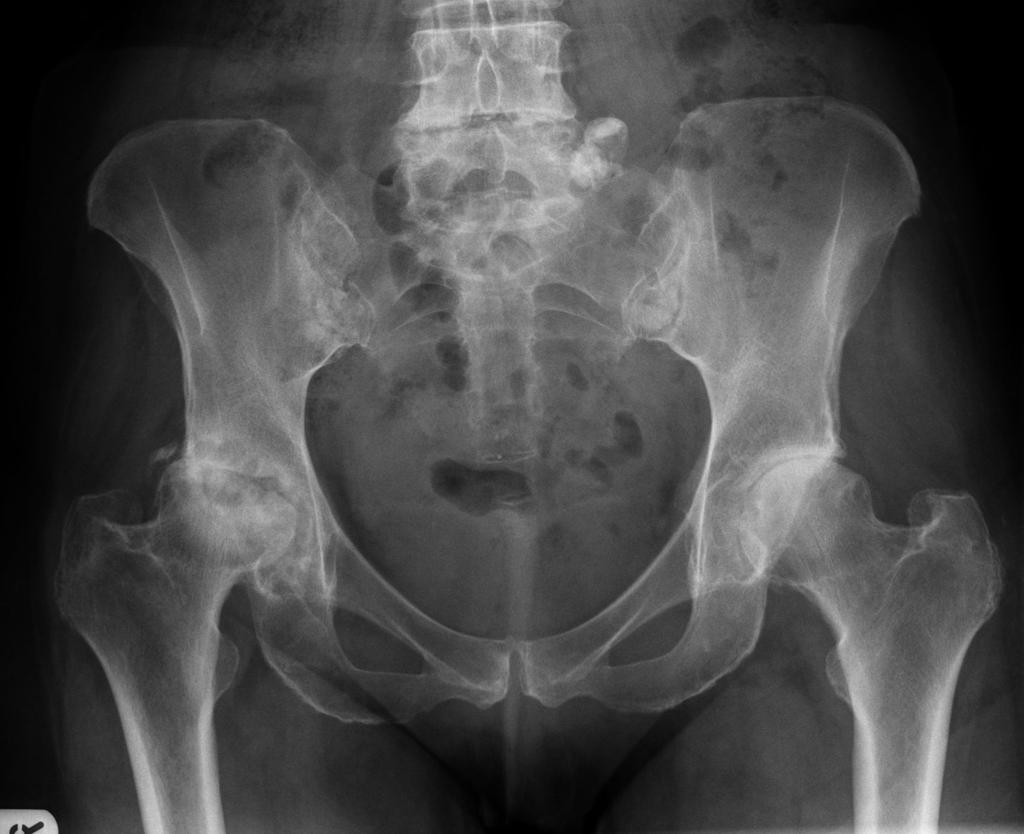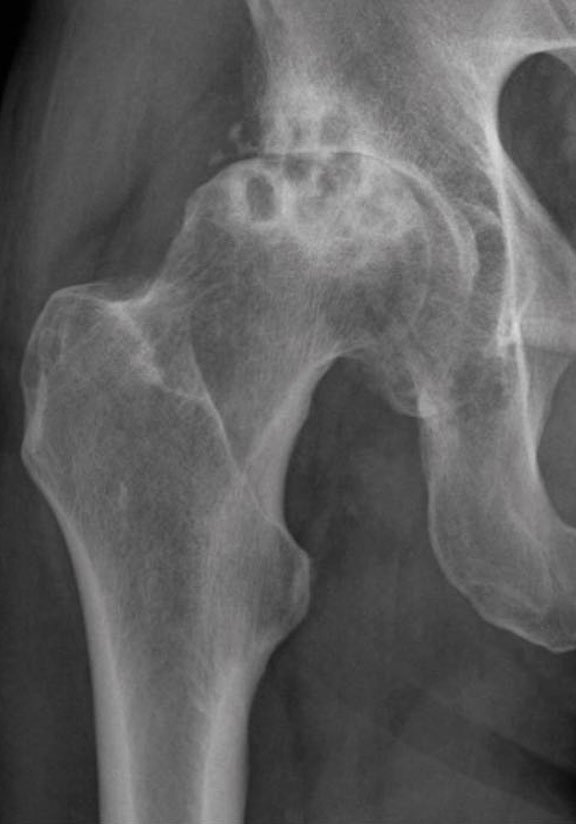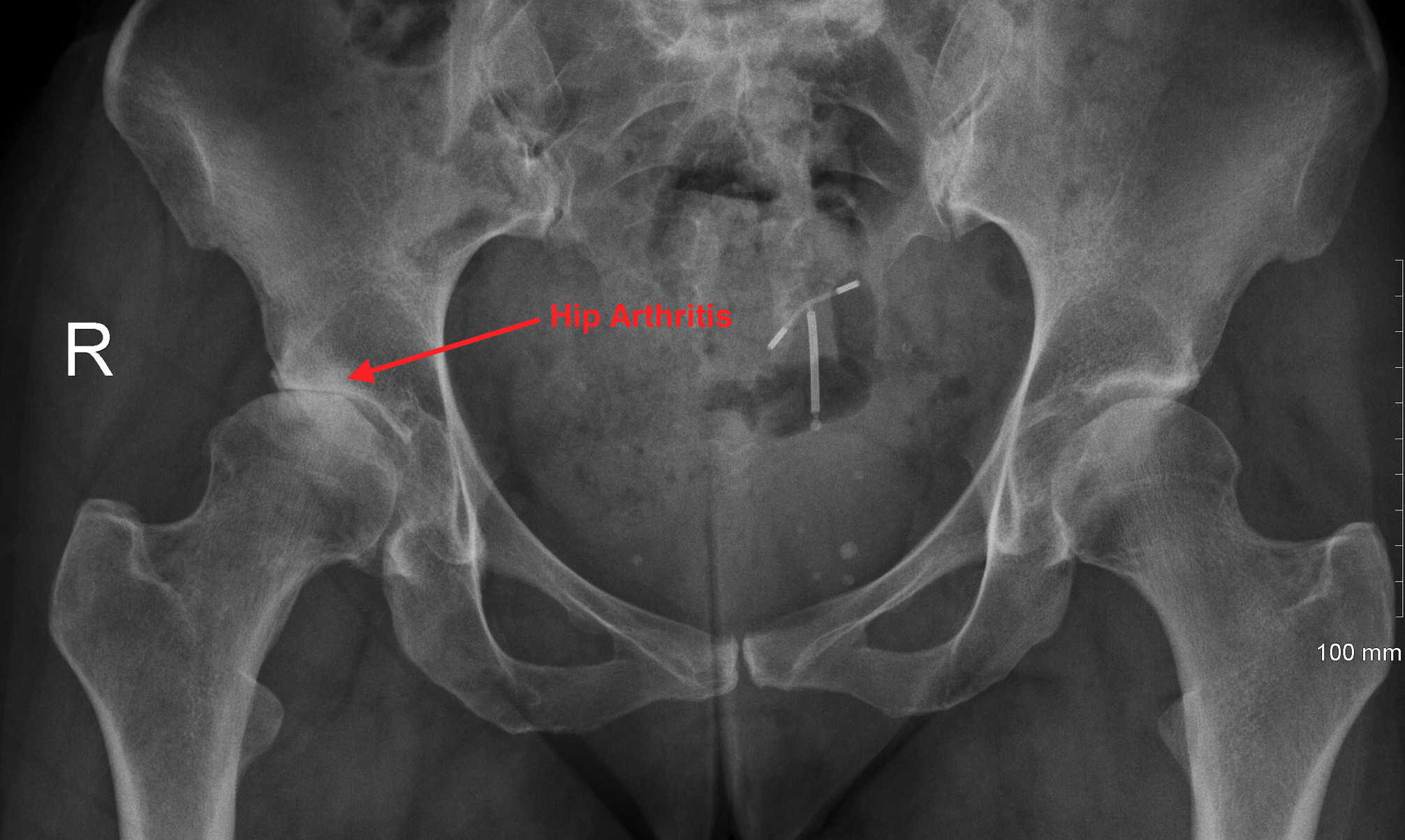Hip Arthritis Treatment Begins With Conservative Care
Studies show that one in four people will develop hip arthritis over the course of their adult life. Many factors play a role in the onset of hip arthritis, including genetics, advancing age, gender, excessive weight, losses in bone density, previous repetitive use or traumatic hip injury, muscle weakness, and joint laxity. Although joint replacement is called for in the most severe cases, hip arthritis treatment includes non-surgical options as well.
Surgical Treatments For Hip Osteoarthritis
When non-surgical treatments dont relieve hip osteoarthritis symptoms, the following surgical options may be recommended.
- Total hip replacement surgery : Removal of damaged bone from the hip socket and the femoral head and replacing it with new joint surfaces .
- Partial hip replacement: Replacement of the ball of the hip joint and leaving the socket intact. This surgery is most often done to repair certain types of hip fractures or isolated arthritis.
- Arthroscopy: Involves smaller incisions and uses tiny cameras and instruments to repair abnormalities in the hip that are contributing to wear and tear.
- Osteotomy: Surgery around the hip to adjust anatomical irregularities that may contribute to wear and tear, while preserving the hips general structure.
Precautions To Keep In Mind Before Exercising With Hip Arthritis
If youre new to exercise, its always smart to first talk to your doctor. Its important to consider the current limits of your joints, and work within those limits, explains Lauren Shroyer, MS, director of product development at the American Council on Exercise. Your doctor or physical therapist can make sure the exercises are safe for you and help you gain strength, without exacerbating inflammation or aggravating joint pain, she says. Likewise, if youve had surgery on your hip, get guidance from your doctor or physical therapist on what hip exercises are safe for you.
More tips to help protect your joints:
Start slowly. Ease your joints into exercise if you havent been active for a while, say experts. Push too hard too fast, and you can overwork your muscles and worsen joint pain. Go easy at first, then increase the length and intensity of your work out as you progress.
Move gently. Warm up your muscles with five to 10 minutes of stretching at the start of every exercise activity, says Dr. Johnson and do it again at the end. Dont force any stretches keep your movements slow and easy. With strength training, begin with fewer reps or lower weight, and build up gradually.
Stop if your hip hurts. Listen to the pain, says Shroyer. Take a break when your joints start to ache or you feel any new joint pain, its time to stop. Talk to your doctor about what pain is normal and when its a sign of something more serious.
Read Also: What Is Rheumatism Pain Like
Stop Thinking You Can’t Exercise
Many people who have arthritis are afraid if they’re active they’ll have more pain and so they just don’t get any exercise. This may be one of the biggest misconceptions about arthritis.
At the same time, it’s an ironic idea because inactivity actually makes pain and disability from arthritis worse over time, while regular exercise keeps joints moving and prevents stiffness, strengthens the muscles around the joints, and improves mobility.
So if you’ve been sedentary out of fear you’ll make your arthritis worse, talk to your healthcare provider to make sure it’s OK to exercise. Then start slowly with gentle, joint-friendly movements. It’s fine to respect your arthritis pain, but you don’t have to let it stop you.
Nonsurgical Treatments For Hip Arthritis

Nonsurgical approaches that reduce pain and disability include:
- activity modification
- weight loss
- physical therapy
The first line of treatment of hip arthritis includes activity modification, anti-inflammatory medication, hip injections and weight loss. Weight loss helps decrease the force that goes across the hip joint. Giving up activities that make the pain worse may make this condition bearable for some people. Anti-inflammatory medications such as ibuprofen, naproxen and the newer Cox-2 inhibitors help alleviate the inflammation that may be contributing to the pain. Furthermore, studies have shown that walking with a cane significantly decreases the forces across the hip joint.
A combination of these non-operative measures may help ease the pain and disability caused by hip arthritis.
Read Also: Arthritis Symptoms In Arms
Treatment For Hip Arthritis
There is no cure for any type of arthritis, including hip arthritis, but there may be more ways to treat the pain and other symptoms than you would imagine.
For most patients with mild hip arthritis, early stages of treatment can include:
- Rest and ice.
- Anti-inflammatory medications .
- Acetaminophen .
Managing Arthritis Pain And Fatigue
Several approaches can be used to manage the pain associated with osteoarthritis of the hip including:
- Activity modification appropriate kinds of exercise and weight loss when necessary may alleviate some hip arthritis symptoms
- Nutritional supplementation are helpful to some patients, although the literature on these supplements is not consistently in favor of their use
- Non-narcotic pain tablets , or over-the-counter non-steroidal anti-inflammatory drugs, if medically appropriate, sometimes are helpful
- Prescription strength, non-steroidal, anti-inflammatory drugs are useful for some patients, though, in general, long-term use of these drugs is discouraged
- Arthritis unloader braces or hip sleeves are helpful for some patterns of arthritis
- Joint injections might help
- Total hip replacement surgery may be used if non-operative interventions dont suffice.
You May Like: Arthritis At 30 Symptoms
How Is Osteoarthritis Of The Spine Treated
In most cases, treatment of spinal osteoarthritis is geared toward relieving the symptoms of pain and increasing a person’s ability to function. The goal is to have a healthy lifestyle.
Initial treatment may include losing weight if needed and then, for everyone, maintaining a healthy weight. It may also include exercise. Besides helping with weight management, exercise can also help:
- increase flexibility
- improve blood flow
- make it easier to do daily tasks
Some of the exercises associated with osteoarthritis treatment include swimming, walking, and water aerobics. Exercise may be broken down into the following categories:
- Strengthening exercises. These exercises seek to make muscles that support the joints stronger. They work through resistance with the use of weights or rubber bands.
- Aerobic exercises. These are exercises that make the heart and circulatory system stronger.
- Range-of-motion exercises. These exercises increase the bodyâs flexibility.
Including rest periods in the overall treatment plan is necessary. But bed rest, splints, bracing, or traction for long periods of time is not recommended.
There are non-drug treatments available for osteoarthritis, including:
- heat or cold compresses, which refers to placing ice or heated compresses onto the affected joint
- transcutaneous electrical nerve stimulation using a small device that emits electrical pulses onto the affected area
- nutritional supplements
Show Sources
Add Ice For Healthy Joints
Ice is a great drug-free pain reliever. It helps relieve joint swelling and numbs pain. If you have a sore joint, apply ice wrapped in a towel or a cold pack to the painful area for no more than 20 minutes. Don’t have ice or a cold pack? Try wrapping a bag of frozen vegetables in a light towel. Never apply ice directly to the skin.
You May Like: Side Effect Of Arthritis
Hip Exercise: Hip Extension
Strengthens your buttocks
- Lie on your stomach on a firm, flat surface with a pillow under your hips. Keep your head, neck, and upper body relaxed.
- Bend one knee 90°.
- Lift your leg straight up.
- Slowly lower your leg down to the floor, counting to 5.
- Do 8 reps then complete the exercise on the other side.
Tip: Begin with 8 reps, using only your body weight and progress to 12, recommends Dr. Johnson. When that becomes easier, add ankle weights in one-pound increments. Each time you increase the weight, start again at 8 reps, working back up to 12.
Hydrotherapy And Physical Therapy
Hydrotherapy is a form of physical rehabilitation that can encourage movement and uses temperature and pressure to encourage blood flow throughout the body. This can reduce pain in the hips.
Standard physical therapy treatments can also help reduce hip pain in patients with arthritis, strains, tears, tendinitis, and other less severe hip problems.
Don’t Miss: Can Arthritis Cause Itchy Skin
Stop Ignoring Your Physical Limitations
Just as there are people with arthritis who aren’t active at all, there are those who push beyond their limits. The trick is to pace your activities. Overdoing it is just as harmful as underdoing it.
Pushing your limits can increase pain and put you at higher risk of joint damage. Respect pain and choose activities with your physical limitations in mind.
Muscle Or Tendon Strain Osteoarthritis And Tendinitis

Pain caused by strains, tendinitis, and some forms of arthritis can be managed at home. Besides the tips above, try tai chi and yoga. These are slow exercises that combine gentle stretching with deep breathing. Both can relax and move the body in ways that wont worsen your pain.
Sign up for a class with a certified instructor to make sure your experience is enjoyable and safe. Once you learn which movements feel best to you, you can use them to treat your pain.
Don’t Miss: Does Rheumatoid Arthritis Hurt All The Time
Surgical Treatments For Hip Arthritis
If the non-operative methods have failed to make a person’s condition bearable, surgery may be the best option to treat hip arthritis. The exact type of surgery depends upon a patient’s age, anatomy, and underlying condition.
Surgical options for hip arthritis range from operations that preserve the hip joint to those that completely rebuild it. They include:
How Is Hip Osteoarthritis Diagnosed
The diagnosis of hip osteoarthritis begins with a physical examination and x-rays. During the physical exam, your physician will examine your hip for pain, swelling and joint stiffness.
Your physician may also order blood tests to examine fluid in the joints. If osteoarthritis is determined to be the cause of symptoms, you may be referred to an orthopaedic specialist who can diagnose the severity of your individual condition.
Also Check: How Does Arthritis Affect Your Body
Coping With Low Mood And Sleep Problems
You might find that osteoarthritis makes you feel depressed or anxious. Speak to your doctor if youre feeling low. They may be able to recommend psychological therapies to help you, such as cognitive behavioural therapy and a few stress-relieving techniques. If your sleep is disturbed because of hip osteoarthritis, this could make your pain feel worse. However, there are things you can do for yourself that might help, such as:
- Keep a sleep diary to work out if there are any patterns to your sleep problems.
- Sleep at regular times to get your body into a routine.
- Try to wind down before bed by having a warm bath or reading a book.
- For a more comfortable sleeping position, use a pillow between your legs if lying sideways, or use a pillow under your knees if lying on your back.
If youre still having problems, speak to your doctor or an occupational therapist. They can give you some tips and techniques. They may also refer you to a pain management clinic, where you can be shown how to live a more active life.
Lie On Your Stomach To Relax Tight Hip Flexors
People with hip pain typically try not to stand much, since it can be an uncomfortable position. But sitting shortens the hip flexor muscles, which can actually increase pain, says Genie Lieberman, the director of the Gloria Drummond Physical Rehabilitation Institute at the Boca Raton Regional Hospital in Florida.
To promote the full extension of the hips, Lieberman recommends lying face down for up to 30 minutes, with small pillows placed under your shoulders for comfort. You can do this on your bed turn your head to either side and rest it on your forearms for comfort. In the beginning, it may be too painful to stay this way for more than a few seconds, but as you stretch the muscles it will get easier.
You May Like: Ra Levels High
What Exercises Should You Avoid For Hip And Knee Osteoarthritis
Experts used to ban high-impact exercises, such as running and jumping, for people with hip and knee OA. The idea was that they could overload and damage the joint. But the opposite may be true for people with mild to moderate OA. âThe impact may stimulate cells that repair in the cartilage,â Oswald says.
But this doesnât mean that you can hop on a treadmill right away. If youâre just starting out, you need to build up your strength and endurance first. This can prevent injury. âThen slowly add in high-impact exercises,â Robertson says. âFor instance, begin with just 5 minutes of jogging.â
Is your OA severe? Chances are youâll need to steer clear of high-impact exercise altogether. Be cautious about the following workouts check with your doctor if youâre able to do them.
- Running, especially on uneven surfaces
- Tennis, basketball, and other activities where you change direction quickly
- Step aerobics and other workouts that involve jumping
Show Sources
Eric Robertson, DPT, physical therapist associate professor of clinical physical therapy, University of Southern California spokesperson, American Physical Therapy Association.
William Oswald, DPT, physical therapist clinical instructor of rehabilitation medicine, NYU Langone Health.
Arina Garg, MD, rheumatology fellow, The Center for Excellence for Arthritis and Rheumatology, Louisiana University Health Sciences Center.
Arthritis Foundation: âStanding Hip Flexors and Quadriceps Stretches.â
What Kind Of Physical Therapist Do I Need
All physical therapists are prepared through education and experience to treat hip osteoarthritis and people with hip replacements. However, you may want to consider:
- A physical therapist who is experienced in treating people with hip osteoarthritis and people who have had hip replacement surgery. Some physical therapists have a practice with an orthopedic focus.
- A physical therapist who is a board-certified orthopaedic clinical specialist. This physical therapist has advanced knowledge, experience, and skills that may apply to your condition.
You can find physical therapists who have these and other credentials by using Find a PT, the online tool built by the American Physical Therapy Association to help you search for physical therapists with specific clinical expertise in your geographic area.
General tips when you’re looking for a physical therapist :
- Get recommendations from family, friends, or other health care providers.
- When you contact a physical therapy clinic for an appointment, ask about the physical therapists’ experience in helping people who have hip osteoarthritis or hip replacement.
- Be prepared to describe your symptoms in as much detail as possible, and say what makes your symptoms worse.
The American Physical Therapy Association believes that consumers should have access to information that could help them make health care decisions and also prepare them for their visit with their health care provider.
You May Like: What Does Rheumatoid Arthritis Feel Like In Hands
Perfect Your Posture For Good Joints
Slouching is not good for your joints. Standing and sitting up straight protect your joints from your neck to your knees. Good posture also helps guard your hip joints and back muscles.
Posture is also important when lifting and carrying. For example, if you use a backpack, be sure to put it over both shoulders instead of slinging it over one. Being lopsided puts more stress on your joints. When lifting, use the biggest muscles in your body by bending at your knees instead of bending your back.
Build Muscles To Support Joints

Strong muscles support your joints. If you don’t have enough muscle, your joints take a pounding, especially your spine, hips, and knees, which must support your entire body weight. Weight training exercises help build muscle and keep your muscles and surrounding ligaments strong. That way, your joints don’t have to do all the work.
A certified personal trainer can show you the best exercises for healthy joints and how to do them correctly. Doing them incorrectly increases the chance of injury.
Recommended Reading: Same Dosage For Arthritis
Knee And Hip Exercises For Osteoarthritis
If you have osteoarthritis in your hips or knees, exercising may be the last thing you feel like doing. Symptoms like pain and stiffness in your joints can make it tough to work out.
But moving is important for hip and knee OA. It causes your joints to compress and release, bringing blood flow, nutrients, and oxygen into the cartilage. âThis can help prolong the function and longevity of your joints,â says Eric Robertson, DPT, a physical therapist and associate professor of clinical physical therapy at the University of Southern California.
Physical activity can also help you feel better. âAlong with boosting your overall health, exercise can improve your OA symptomsâ like pain, stiffness, fatigue, and even depression, says Leigh F. Callahan, PhD, associate director of the University of North Carolina Thurston Arthritis Research Center. One study found that people with knee OA who worked out regularly lowered their pain by 12% compared to those who didnât.
Ready to lace up your sneakers? No single workout is best. But some moves are better for hip and knee OA. Experts recommend doing a mix of the following three exercises. But first, remember to check in with your doctor before you start any new physical activity.